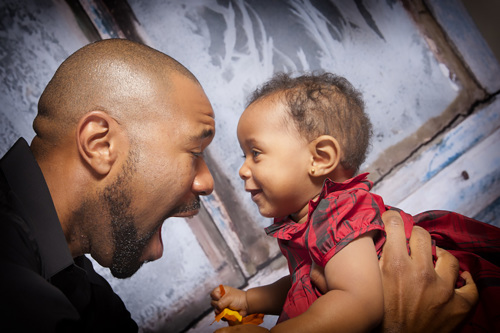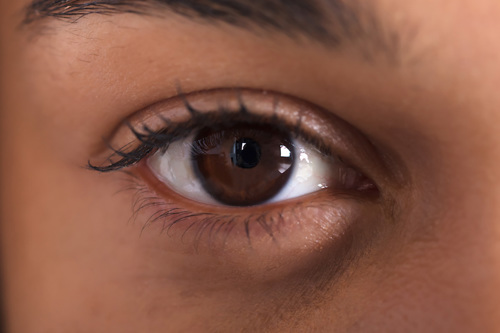
What are the chances a child will look more like their father than mother?
October 22, 2014

- Related Topics:
- Complex traits,
- Appearance,
- Relatedness,
- Dominant and recessive,
- Punnett squares
A graduate student from New York asks:
“What are the chances a baby will come out looking more like the father or getting more of the father’s genes?”
First off, each child will pretty much get the same number of genes from dad. Boys and girls will get a slightly different set, but these genes won’t affect the sort of traits you are talking about. And all the sons will all get the same number of dad’s genes. And the same goes for all the daughters.
So getting fewer or more genes from a parent is not the reason that a child favors that parent. Instead, it has to do with the versions of each gene you get from each parent, and what traits that combination will give.
This means that under some circumstances, each child will have a really good chance at favoring dad while in others, they’ll have a better chance of favoring mom. And sometimes a child won’t favor either and may look more like an uncle or an aunt or different from everyone else in the family. That is the beauty of genetics!
Because of this it is very difficult to predict beforehand which parent a child will look like. You have a better shot if you know each parent’s DNA, but even then you don’t know for sure. You might be able to say the child has a 50% chance of having dad’s red hair or a 25% chance of having his blue eyes.
To illustrate this point, I will give an example of two parents and go over a few scenarios where the genes work out so that one parent is favored and another where a blend of the two is favored. Then I’ll go over a third where the child doesn’t favor either parent.

Genetics 101
In our examples, I will focus on a red haired, blue eyed mom and a brown haired, brown eyed dad. As you’ll see, in some cases all the kids will look like dad and in others, they’ll come out looking like dad, mom, or a combination of the two.
Before seeing how these are all possible, we need to take a step back and do a quick review of genes and how they work. Don’t worry, this will be quick…
First off, we have two copies of each of our genes, one from mom and one from dad. So we have two copies of the gene that can lead to red hair and two copies of the brown/blue eye color gene. (As you’ll see later, eye color is more complicated than this.)
What makes each of us different is not that we have different genes but that we have different versions of the same genes. So for example we all have the MC1R gene but some of us have a version (or as scientists call it, an allele) that can give red hair and the rest of us have a version that won’t give red hair. Something similar happens with eye color too.
OK, since we have two copies of the MC1R gene and it comes in two versions, we can each have any of three possible combinations of this gene. To make things simpler, when I show the combinations, I will represent the not-red version with an R and the red version with an r.
So here are the three possible combinations:
- RR = Not red
- Rr = ?
- rr = Red
The hair color of two of these combinations is obvious and so I have included them. Someone who is RR won’t have red hair and someone who is rr will. The tricky one is people who have one of each, Rr people.
Turns out that for the most part, Rr people do not have red hair. That is because not having red hair is dominant over having red hair. Another way to say this is that red hair is a recessive trait. So here are the three combinations again:
- RR = Not red
- Rr = Not red
- rr = Red
Brown and blue eyes work similarly in that brown eyes (B) are dominant over blue (b). Which of course means that blue eyes are recessive. So BB and Bb people have brown eyes and bb people have blue.
Now we are ready to look at our two parents and their kids. As you’ll see, each parent’s hidden, recessive genes affects the chances that a child will look like a parent.
Favoring One Parent or Being a Blend
Imagine a red haired, blue eyed mom and a brown haired, brown eyed dad. From this we know what genes mom probably has. Her red hair means she is rr and her blue eyes mean she is bb.
Dad, though, is trickier. He can be any of these four possible combinations:
- RRBB
- RrBB
- RRBb
- RrBb
All four of these people would have brown hair and brown eyes because they all have at least one R and one B. But the chances of favoring dad, instead of our red haired, blue eyed mom, vary with each.
Let’s first imagine the RRBB dad. Remember that each parent passes just one copy of each of their genes to each child. This dad can only pass an R and a B because that is all he has to give.
Our red haired, blue eyed mom can only pass an r and a b for the same reason. This means that every child will be RrBb—they will all have brown hair and brown eyes. They will all favor dad.
If we instead look at an RrBb dad, then we can get completely different results. In this case dad can pass either a B or a b and either an R or an r. This leads to four possible children:
- RrBb = Brown hair, brown eyes
- rrBb = Red hair, brown eyes
- Rrbb = Brown hair, blue eyes
- rrbb = Red hair, blue eyes
(Go to the end of the article if you are interested in seeing how I figured this out.)
Now each child has a 25% chance of favoring dad, a 25% chance of favoring mom and a 50% chance of being a blend of the two.
Depending on dad’s genetic combination, the children can all favor dad or only some can favor dad. The other possible genetic combinations or genotypes each have a 50% chance of favoring dad and a 50% chance of being a blend.
Of course, the same would be true for a red haired, blue eyed dad and a brown haired, brown eyed mom. Except that there would be some cases where mom was always favored.
And Now For Something Completely Different
So far we have focused on a child favoring one parent or being a blend of the two. It is also possible for them to be different from both parents. For this I will focus on eye color but something very similar happens with hair colors other than red.
Eye color is a bit more complicated than I have painted here. At its simplest, there are actually two eye color genes (and this isn’t nearly complicated enough to really explain eye color).
One gene is the one we described that comes in two versions, brown and blue. But there is a second one that also comes in two versions, green and blue.
The two genes are related in that brown is dominant over green, and blue and green are dominant over blue. Which also means blue is recessive to green, and blue and green are recessive to brown.
That was probably confusing so here is a table of each of the possible gene combinations and the color eyes they would have:
|
BB bb |
Brown |
|
BB Gb |
Brown |
|
BB GG |
Brown |
|
Bb bb |
Brown |
|
Bb Gb |
Brown |
|
Bb GG |
Brown |
|
bb GG |
Green |
|
bb Gb |
Green |
|
bb bb |
Blue |
As you can see, whenever there is a B you have brown eyes. When there is a G but no B you have green eyes and if you only have b’s, you have blue eyes.
Let’s go back to our original example. Mom has blue eyes and so is bbbb. Dad can be any of six possible combinations but let’s say he is BbGG.
In this case, each child has a 50% chance of getting a B and favoring dad and a 50% chance of getting a G without a B and favoring neither parent. The child would have green eyes even though the parents have brown and blue. If grandma had green eyes, we’d say that the child favors grandma and not the parents.

Now imagine adding more and more genes, each with their own different versions. Maybe the parents have wavy hair and the child ends up with straight hair, maybe our brown haired dad and red haired mom have a blonde child, maybe the child has dad’s nose, maybe…
As you can see, things get messy fast! A child will not always favor one parent or the other, it depends on each parent’s genetic combinations. And a bit of chance about which genes happen to get passed on.
Figuring Out Hair and Eye Color Combinations
To figure out why we got the results we did with an rrbb mom and an RrBb dad, we need to break out the old Punnett square. In a Punnett square, we make a table where all of the possible combinations of alleles that dad can pass down are put along the top and mom’s possible combinations are put along the side like so:
|
|
RB |
rB |
Rb |
rb |
|
rb |
|
|
|
|
Mom has only one combination she can pass on, rb, and dad has four. You then match up each box and get, in this case, four possible combinations:
|
|
RB |
rB |
Rb |
rb |
|
rb |
RrBb |
rrBb |
Rrbb |
rrbb |

Author: Dr. D. Barry Starr
Barry served as The Tech Geneticist from 2002-2018. He founded Ask-a-Geneticist, answered thousands of questions submitted by people from all around the world, and oversaw and edited all articles published during his tenure. AAG is part of the Stanford at The Tech program, which brings Stanford scientists to The Tech to answer questions for this site, as well as to run science activities with visitors at The Tech Interactive in downtown San Jose.
 Skip Navigation
Skip Navigation
